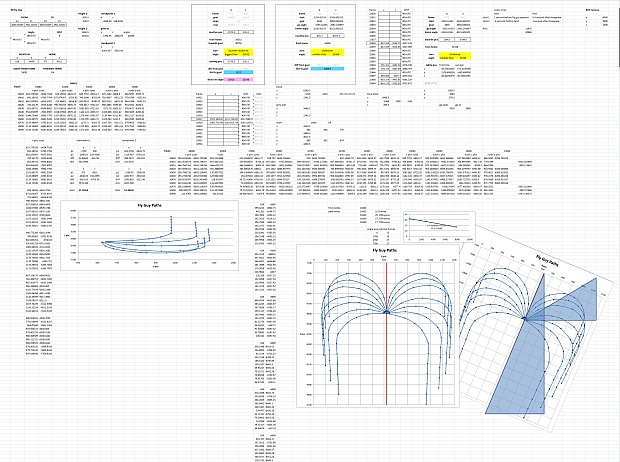How Tool-Assisted Speedrunning Reveals The Inner-Life Of Video Games
Meet the obsessives deconstructing Mario 64
If you watched this year's Awesome Games Done Quick, you're already familiar with the Olympian feats of endurance and skill that players exhibit as they race through your favorite games and make you realize that, no, you aren't nearly as good at them as you might have thought. But there's another side to the coin that isn't nearly as popular as traditional speedrunning, a niche community of players prying open games and doing the unimaginable. Tool-assisted speedrunning ('TAS') might seem like simple cheating, but it's so much more than that. It's an exploration of the inner-life of video games, and it takes teams of expert players and programmers thousands of hours to do.
For many of us, a video game ends when the credits roll or when every challenge has been mastered—if we even make it that far. But for Scott "pannenkoek2012" Buchanan, Super Mario 64 has no end. It's a game that he has mastered both inside and out, and his knowledge of its inner clockwork borders on academic. By using emulators and memory hacking software, Scott is able to play Mario at a level that is impossible by traditional means. He can control Mario frame by frame, maneuvering him in ways even the average speed runner only dreams of doing. His staggering understanding of the game's programming and the glitches it spawns allows him to combine both to fascinating effect.
"I've been playing Mario since before I can remember," Scott told me one afternoon as we chatted over Skype. As a child, it was the first game he ever played. But unlike most of us, once Scott had finally mastered every challenge Super Mario 64 offered, he wasn't ready to move on. Using sm64.com, Scott's "bible" for the game, he began seeking greater challenges, like collecting every coin on every level. Through the website, he even discovered there were three different levels that, with careful use of a glitch, a player could potentially gather infinite coins. But being just a kid wrestling with the N64's awkward controller, Scott found he lacked the dexterity for these greater challenges and eventually drifted away from the game.
It wasn't until several years later, as a teenager, that Scott rediscovered his love of Super Mario 64 thanks to an emulator he downloaded onto his computer. Adamant that he would now beat the challenge his childhood self had failed to master, Scott discovered something interesting: It wasn't just three levels that Mario could gather infinite coins on but many more. Excited by this new discovery, Scott made his first YouTube video to share his findings with the world and took his first steps into the community of tool-assisted play.
Meet The TAS Team
Today, Scott is one of the more popular tool-assisted runners in the entire community. He works with a team of 12 other players who have transformed Super Mario 64 from a game into a science. But not content to be just scribes, they use their masterful knowledge of these glitches to do incredible things. In 2014, for example, Scott collected a coin that players had known about for 12 years but been unable to reach by exploiting geometry in the world.
Scott's main focus now is the ''A' button challenge', a bid to figure out the optimal way of beating Super Mario 64 both by collecting all 120 stars (called a 100% run) or going straight for the finish line (called an any% run). Thanks to Scott and his peers, the 'A' button challenge has been reduced from 118 presses down to 32 for the 100% run. He's even working on a "no button challenge" to beat the game using only the joystick.
This incredible reduction of presses is thanks to Scott and the Facebook group of 12 other Mario 64 'TASers' he collaborates with. "Each one of us has a really good strength that no one else has, so it's really helpful that we're all together and can communicate so easily," he said. When I asked Scott what he felt he brought to the group, he was quick to answer: "I'm creative in coming up with new strategies and I have a lot of patience. If something doesn't work I'll keep trying it and keep thinking about new possibilities." That patience goes well beyond running into walls when trying to figure out a new method. Scott's tool-assisted runs can frequently take him up to 12 hours to complete a single movement—often just to save a single 'A' press.
Tyler Kehne is another influential member of the inner circle of Mario TASers. When Scott's videos were first gaining popularity, it was common for viewers to suggest solutions in the comments, but the vast majority of them were coming from people not nearly as educated as Scott. That was until Tyler started reaching out and blew Scott away with his knowledge of the game. "He started showing me stuff and I was like, whoa, this is a guy to be reckoned with. He showed me things I had never thought of," Scott said.
Tyler uses his skills as a computer programmer to unravel Super Mario 64's more esoteric secrets. He was the person who discovered the complicated trick of 'parallel universes', a term he coined after discovering a way to desync Mario's actual position on a map and the position the game uses to check if he is standing on solid ground.
Parallel universes were a massive breakthrough for the 'A' button challenge because, paired with another glitch called 'hyperspeed walking', it allowed Mario to gather enough speed to essentially break free from the map entirely, even though his ground-check position still remained behind. This trick places Mario on an invisible duplicate of the map, since the game thinks Mario is technically on solid ground when he is in fact way out of bounds. These duplicates extend in a grid an infinite number of times. With enough built up speed a TASer can move Mario around a level by causing him to break through the geometry and travel to new parallel universes, thus circumventing obstacles that would otherwise require an 'A' press. If it sounds complicated, that's because it is.
What Tools Are Used For Speedrunning
Such complicated methods often require complicated calculations, something that Scott excels at. During our chat, he showed me his workbook containing over 20 different spreadsheets of all of his research. Everything from the flight paths of certain enemies to calculations of how much speed Mario needs to perform a parallel universe movement are meticulously detailed and graphed.
The values for his calculations are gleaned through the use of memory hacking software like Cheat Engine, which can peek into specific addresses in RAM that a program assigns and read back whatever is stored there. Variables like Mario's coordinates or the vertices of polygons can be determined, but doing so requires first knowing where to look.
An important distinction to make is that everything Scott and his peers accomplish is theoretically possible using an unassisted version of the game. Though they certainly have the tools to hack Super Mario 64 ROMs or pry open the values stored in specific RAM addresses and change them as they please, these methods are only used to study and understand the game and not in the actual runs used to complete challenges.
One member of the group is even working on a modified controller that can interface with an N64 console and input the same sequences of button presses used on emulators to verify that what is done on an emulator is possible on the native hardware. This was most recently done to verify a method Scott had devised by cloning several goombas to make a ladder to avoid an 'A' press. It was a process that, due to the limitations of the N64's hardware, he was worried would crash the console if it ran out of memory, but was relieved to discover it didn't.
When it comes to actually performing the run, all Scott uses are the tools provided by the emulator, a controller plugin to offer greater precision, and the memory hacking software to see any values he might need in order to perform his complex maneuvers. He also uses a wired Xbox 360 controller to play the game because the extra buttons allow him to assign necessary emulator functions that he needs easy access to.
In a demonstration, Scott showed me how to exploit a 'misalignment' to allow Mario to snap up onto a higher ledge without using the 'A' button. By first standing on the ledge, Scott was able to determine the specific vertice he needed Mario to jump into to cause him to teleport upwards. Then, using save states to retry and correct failed attempts and Xbox 360 buttons to move the game forward frame by frame, he had Mario dive (which doesn't require the 'A' button) toward the vertice several times. Using the controller plugin to correct his movement by a fraction of degrees, Scott was able to time the jump perfectly to collide with the level geometry in such a way that he would be pushed up onto the ledge instead of away from it. In total, the whole process took minutes to complete a move that, in real time, would have been seconds.
On page two, how glitches are found in the first place.
How Do You Find Glitches
But how are these glitches even discovered in the first place? It was a big question I had for Scott, and one that doesn't really have a concrete answer. Many of them were discovered by average players messing around in the game, either recorded or shared through word of mouth. Others, such as Tyler's parallel universes, were discovered by popping open the hood and observing how Super Mario 64 works.
In one instance, a speedrunner had recorded a video where a bob-omb followed Mario before he turned and dove to grab it, causing the bob-omb to vanish and instantly appear nearby. "Four or five of us started trying to recreate this exact scenario," Scott said. "But we didn't know what was redundant and what was necessary for the glitch to work."
Serendipitously, Scott remembered a somewhat similar glitch in which Mario can hold his hat and pick up other objects, causing them to teleport when he puts them back down. What Tyler and Scott discovered was that the variable (called the 'holp' or 'held objects last position') used to store the position of objects Mario is holding will retain the value of the coordinates of the last held object once Mario releases it—even if he enters a new zone. If Mario is holding an object but the holp isn't updating to the object's current coordinates, such as when Mario is holding his hat, then when he releases an object it will appear at the holp's position, not where Mario puts it down.
This similar glitch led them to discover that if Mario grabs an object and bumps his head in the same frame, causing him to release the object, the holp won't have a chance to update its coordinates, thus moving the object to the holp's last position. Finally, the team had cracked 'The Mystery of the Vanishing Bob-omb'. Now, manipulating the holp has become a strategy that Scott uses to shave a few 'A' presses off of his videos.
But no matter how a glitch is initially discovered, Scott and the team use the same process for documenting them. First, the glitch must be isolated and recreated. Secondly, it must be understood. Using Mupen64, a popular N64 emulator, Scott can create an .m64 file that records a sequence of inputs and plays them back in the emulator, duplicating the exact processing and rendering of the game. "If we have it on a file like that, I can give it to Tyler and he'll look into the nitty-gritty code and look at what calls are making it happen," Scott said.
Earlier this year, Scott became aware of a potential glitch when a Twitch streamer suddenly teleported a huge vertical distance without reason. Given the hardest part of not using the 'A' button is gaining height, Scott saw its potential as one of the biggest glitches ever discovered. Because Scott only had the video to go by, he spent hours trying to trigger the glitch. He's even offering a thousand dollar bounty for anyone who could demonstrably recreate it. But months later, the problem remains unsolved.
Scott isn't convinced it could be a true glitch, either. During his research, he discovered that hacking and changing a single bit in Mario's vertical position at the same moment in the original video had Mario teleport upwards in a similar fashion . "If you change the last bit from a one to a zero, you get exactly what we saw," Scott explained, adding that popular theories suggest a gamma ray entered the Twitch streamer's computer and happened to flip the bit or that a malfunction in the cartridge caused the miniscule change.
Pure Versus. Tool-Assisted Speedrunning
One of the biggest misconceptions surrounding the TAS community stems from its origins as a form of speedrunning. It's not uncommon to find people who turn their noses up at TAS, condemning it as cheating compared to the purity of traditional speedrunning. But to do so isn't only reductive of the work and effort invested by these players, it's fundamentally ignorant of the reason they do it. "The goal isn't to show how good we are at playing the game, the goal is to show what's theoretically possible," Scott said. "I think a lot of people refuse to accept the difference."
Perhaps this misunderstanding comes from the way that TAS can so often look like pure sorcery. Unlike speedrunning, much of what Scott accomplishes isn't immediately understandable by the average observer, and so many dismiss it the same way you'd dismiss someone claiming they beat a game when all they did was turn god mode on.
After talking with Scott, it's hard to not imagine him and his friends as more akin to scientists than athletes. Like our own reality, Super Mario 64 is ruled by a set of laws that govern the purpose and action of everything contained within it. What's so fascinating is how much Scott is able to do not with the logic contained within the lines of code but with the gaps in between. It made sense for a programmer to put a hard cap on Mario's forward speed, but who could have foreseen that leaving his reverse speed uncapped could lead to all sorts of clever tricks?
If speedrunning is a celebration of human endurance and skill, tool-assisted play is a celebration of human curiosity and understanding. And though they might feel distant, both share a common ancestor in the question "how can I do it better?" For Scott though, this obsession to understand Super Mario 64 comes from a simple, almost childlike place: "I loved Super Mario 64, and I never wanted it to end. It wasn't until I was able to play it on my computer using an emulator that the ceiling of what I could do and test became infinite."
Perhaps Shigeru Miyamoto put it best when he said, "What if everything you see is more than what you see? The person next to you is a warrior and the space that appears empty is a secret door to another world? What if something appears that shouldn't? You either dismiss it, or you accept that there is much more to the world than you think. Perhaps it really is a doorway, and if you choose to go inside, you'll find many unexpected things."
This article was made possible by your funding via the RPS Supporter Program. Thank you!















